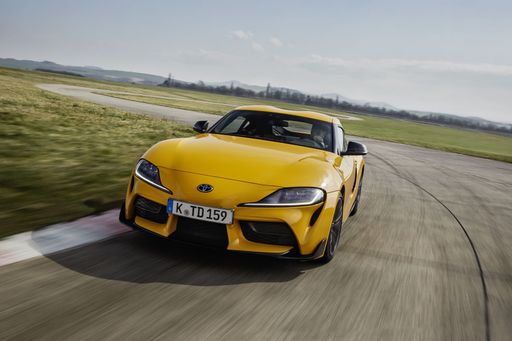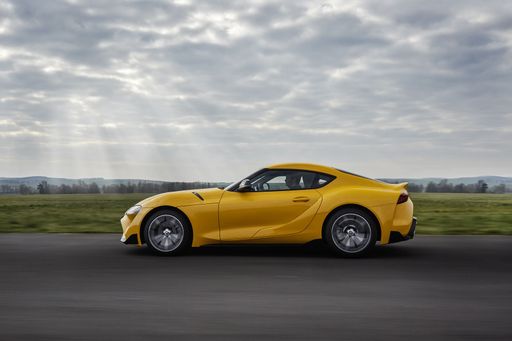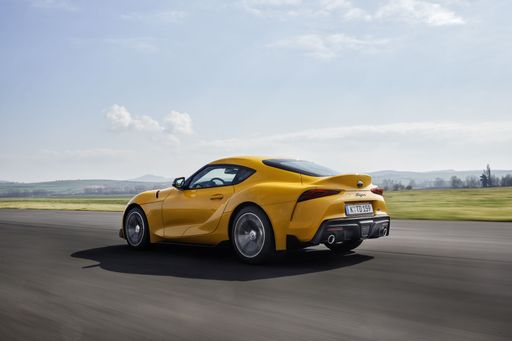Toyota Supra VS Maxus eTERRON 9 – Specs, Efficiency & Price Comparison
Which model is the better choice – the Toyota Supra or the Maxus eTERRON 9? We compare performance (258 HP vs 442 HP), boot capacity (290 L vs ), efficiency (7.10 L vs 26.70 kWh), and of course, the price (45300 £ vs 64200 £).
Find out now which car fits your needs better!
The Toyota Supra (Coupe) is powered by a Petrol engine and comes with a Automatic transmission. In comparison, the Maxus eTERRON 9 (Pickup) features a Electric engine and a Automatic gearbox.
When it comes to boot capacity, the Toyota Supra offers 290 L, while the Maxus eTERRON 9 provides – depending on what matters most to you. If you’re looking for more power, you’ll need to decide whether the 258 HP of the Toyota Supra or the 442 HP of the Maxus eTERRON 9 suits your needs better.
There are also differences in efficiency: 7.10 L vs 26.70 kWh. In terms of price, the Toyota Supra starts at 45300 £, while the Maxus eTERRON 9 is available from 64200 £.
Compare all the key specs now and find out which model fits your lifestyle best!
Toyota Supra
The Toyota Supra stands as an iconic symbol in the world of sports cars, blending striking aesthetics with performance. Its sleek design and elegant curves capture attention, while the finely tuned engine offers an exhilarating driving experience. Inside, the driver-focused cockpit combines luxury with cutting-edge technology, ensuring both comfort and excitement on the road.
details @ toyota-media.de
@ toyota-media.de
 @ toyota-media.de
@ toyota-media.de
 @ toyota-media.de
@ toyota-media.de
Maxus eTERRON 9
The eTERRON 9 stands out with its striking design and innovative features, making it a compelling choice for eco-conscious drivers. Its spacious interior and advanced technology provide a seamless driving experience that prioritizes both comfort and connectivity. With impressive efficiency and an array of smart capabilities, the eTERRON 9 is redefining what modern electric vehicles can offer.
details

|
|
|
|
|
Costs and Consumption |
|
|---|---|
|
Price
45300 - 49200 £
|
Price
64200 - 66800 £
|
|
Consumption L/100km
7.10 L
|
Consumption L/100km
-
|
|
Consumption kWh/100km
-
|
Consumption kWh/100km
26.70 kWh
|
|
Electric Range
-
|
Electric Range
430 km
|
|
Battery Capacity
-
|
Battery Capacity
-
|
|
co2
161 g/km
|
co2
0 g/km
|
|
Fuel tank capacity
52 L
|
Fuel tank capacity
-
|
Dimensions and Body |
|
|---|---|
|
Body Type
Coupe
|
Body Type
Pickup
|
|
Seats
2
|
Seats
5
|
|
Doors
3
|
Doors
4
|
|
Curb weight
1395 kg
|
Curb weight
2925 - 2955 kg
|
|
Trunk capacity
290 L
|
Trunk capacity
-
|
|
Length
4379 mm
|
Length
5500 mm
|
|
Width
1854 mm
|
Width
1997 mm
|
|
Height
1292 mm
|
Height
1860 mm
|
|
Payload
315 kg
|
Payload
545 - 575 kg
|
Engine and Performance |
|
|---|---|
|
Engine Type
Petrol
|
Engine Type
Electric
|
|
Transmission
Automatic
|
Transmission
Automatic
|
|
Transmission Detail
Automatic Gearbox
|
Transmission Detail
-
|
|
Drive Type
Rear-Wheel Drive
|
Drive Type
All-Wheel Drive
|
|
Power HP
258 HP
|
Power HP
442 HP
|
|
Acceleration 0-100km/h
5.20 s
|
Acceleration 0-100km/h
5.80 s
|
|
Max Speed
250 km/h
|
Max Speed
190 km/h
|
|
Torque
400 Nm
|
Torque
700 Nm
|
|
Number of Cylinders
4
|
Number of Cylinders
-
|
|
Power kW
190 kW
|
Power kW
325 kW
|
|
Engine capacity
1998 cm3
|
Engine capacity
-
|
General |
|
|---|---|
|
Model Year
2020
|
Model Year
2025
|
|
CO2 Efficiency Class
F
|
CO2 Efficiency Class
A
|
|
Brand
Toyota
|
Brand
Maxus
|
Toyota Supra
A Revitalised Icon: The Toyota Supra
The Toyota Supra has been a byword for performance and style since its inception. In its latest iteration, the Supra continues to captivate automotive enthusiasts with its blend of heritage and modern innovation. With a stunning profile and state-of-the-art engineering, the Toyota Supra is more than just a sports car; it’s a testament to Toyota’s commitment to excellence.
Engineering Excellence Under the Hood
At the heart of the Toyota Supra lies a sophisticated 2.0-litre turbocharged four-cylinder engine. This power unit, with a displacement of 1998 cm3, provides a thrilling 258 PS (190 kW) and an impressive torque output of 400 Nm. Such output doesn’t come at the cost of efficiency, as the Supra’s fuel consumption stands at an economical 7.1 L/100 km, supported by an automatic transmission that emphasises smooth power delivery and driving comfort.
Driving Dynamics and Performance
Driving the Toyota Supra is an experience defined by precision and agility. With an acceleration from 0 to 100 km/h in just 5.2 seconds and a maximum speed of 250 km/h, the Supra emboldens its driver with confidence. The rear-wheel-drive layout provides dynamic prowess, ensuring a well-balanced and responsive performance on both straight roads and winding tracks.
Design: A Nod to Tradition with Modern Flair
The design of the Toyota Supra is a harmonious blend of old and new. Its coupe silhouette is characterised by sleek lines and an assertive stance, true to its sports car roots. Measuring 4379 mm in length, 1854 mm in width, and 1292 mm in height, the Supra asserts itself with a compact yet muscular profile. The bold aesthetics are complemented by innovative features that emphasise aerodynamics and driving stability.
Safety and Technological Innovations
Toyota embeds cutting-edge technology within the Supra to enhance driver and passenger safety. Modern connectivity options, driver-assistance systems, and a CO2 efficiency class of F reflect Toyota’s dedication to integrating technology without compromising performance. The Supra’s technologically advanced cockpit connects seamlessly with today’s demand for a digitally proficient driving environment.
Comfort and Practicality
Despite its focus on performance, the Toyota Supra does not neglect practicality. Offering a surprisingly spacious 290 litres of boot space and a tank size of 52 litres, it accommodates both the need for speed and everyday usability. The interior craftsmanship prioritises comfort, ensuring that the Supra remains a suitable companion for both the daily commute and longer escapades.
Conclusion: An Icon Reimagined for the Future
The Toyota Supra stands out not only as a reborn icon but as a forward-thinking sports car that embodies Toyota’s innovative spirit. With a range of options such as the Dynamic Automatik and Pure Automatik trims, the Supra offers tailored experiences for its discerning audience. Ultimately, this modern legend continues to inspire car lovers, representing a perfect harmony of heritage and innovation.
Maxus eTERRON 9
The automotive industry is witnessing a remarkable transformation as electric vehicles (EVs) become more mainstream. One of the standout entrants in this rapidly evolving marketplace is the Maxus eTERRON 9, an electric pickup that combines cutting-edge technology, impressive performance metrics, and an appealing design. This model, tailored for modern consumers and businesses alike, is revolutionizing the way we view utility in an EV format.
Stunning Performance Metrics
The eTERRON 9 is a powerhouse of performance, boasting an impressive 442 horsepower generated by its electric engine. This output allows for exhilarating acceleration, enabling it to go from 0 to 100 km/h in just 5.8 seconds. The automatic transmission paired with the all-wheel-drive system ensures a smooth and dynamic driving experience, making it as adept at navigating city streets as it is on rugged terrain.
Innovative Efficiency
In a world increasingly focused on sustainability, the Maxus eTERRON 9 stands out with its impressive efficiency, consuming only 26.7 kWh per 100 km. This efficiency does not come at the cost of range; the eTERRON 9 is capable of covering up to 430 km on a single charge, making it suitable for both daily commutes and longer journeys. Its CO2 efficiency class of A further highlights its commitment to reducing emissions, with a remarkable 0 g/km CO2 output, ensuring environmentally conscious driving.
Design and Practicality
The exterior dimensions of the eTERRON 9 are quite grand, measuring 5500 mm in length, 1997 mm in width, and 1860 mm in height. This gives the pickup a commanding presence on the road, while also offering a spacious interior. With a seating capacity for five, the cabin is designed for comfort and utility, ensuring that passengers enjoy ample space even on longer trips. The eTERRON 9 also features four doors, thereby maximizing accessibility for all occupants.
Payload and Versatility
One of the eTERRON 9’s standout features is its impressive payload capacity, ranging from 545 to 575 kg, depending on the specification. This makes it an ideal choice for businesses needing a reliable vehicle for transporting goods, as well as for outdoor enthusiasts looking to carry extra gear on their adventures. The combination of electric power and significant payload capacity means that the eTERRON 9 doesn't just perform well—it adapts to a variety of practical situations.
Technological Innovations
The technological suite in the Maxus eTERRON 9 is nothing short of revolutionary. With advanced infotainment systems and connectivity features, drivers can easily access navigation, music, and vehicle diagnostics through intuitive interfaces. Additionally, safety remains a paramount focus, with state-of-the-art driver-assist technologies helping to prevent accidents and enhance overall vehicle control.
Conclusion: The Future of Electric Mobility
The Maxus eTERRON 9 is not just another electric vehicle; it represents a significant step forward in the integration of electric power into traditional utility segments such as trucks and pickups. With a perfect blend of performance, efficiency, design, and technology, the eTERRON 9 stands poised to capture the attention of both daily drivers and commercial enterprises alike. As we move into a more sustainable future, vehicles like the eTERRON 9 will play a crucial role in shaping how we view transportation.
The prices and data displayed are estimates based on German list prices and may vary by country. This information is not legally binding.
